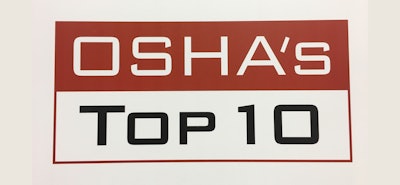
Here we have it. The OSHA Top 10 violations. The biggest list of the biggest citations given out in the past year. It seems that very little has changed from last year’s list.
And people may run the risk of not paying attention because it’s the same.
But that’s a risk you don’t want to take. So what are you supposed to do with it?
Well, when it comes to making sense of the OSHA Top 10, Grainger’s got your back. Below are insights from 10 Grainger safety professionals on the Top 10 and how they can help you keep your facility and your people safe as well as compliant.
(This is part one of a two part series. Read part two here.)
1) Using The Top 10 List To Improve Your Organization
By Travis Kruse, Grainger Sr. Director, Safety Strategy and Solutions
Evaluating the OSHA Top 10 and how it speaks to you and your facility is no easy task. You want to make the most of it. But how do you take the list and use it to make your organization better, apply lessons learned and avoid these same costly mistakes that can lead to injuries, illness and reputation risk?
According to Grainger’s Senior Director of Safety Strategy and Solutions, Travis Kruse, examining the OSHA Top 10 itself and understanding how they come up with it is a good start. “There is only one compliance officer for every 59,000 workers in the United States.1 If you look at the number of inspections and the number of regulators OSHA has, OSHA is only finding a small subset of the hazards and regulatory violations troubling organizations today. OSHA takes many things into consideration when determining where to inspect. However we know that citations are predominantly the outcome of OSHA’s programmatic inspection process based off of their annual Special Emphasis Program (SEP) as well as employee complaints where OSHA has a legal obligation to investigate.”
In addition, OSHA is combing available injury and illness data from various sources including the Bureau of Labor Statistics (BLS) to ensure they are focusing their efforts in those areas leading to the most severe injuries and illnesses. The Top 10 list isn’t arbitrary. It is a reflection of the most frequent findings by OSHA warranting citation. Those sobering numbers mean OSHA is also perhaps missing a lot of hazards and violations. So making that information clear for organizations, so they know where to look for missed violations in their own facilities, is a major part of the OSHA Top 10.
Too many organizations feel they have addressed many of the regulatory compliance aspects associated with their health and safety programs and feel they are in compliance today. These attitudes could be creating a false sense of security as regulatory requirements continue to change, and staying abreast of these changes and modifying your programs can be laborious. “They think they are in compliance and everything is fine,” says Travis. “But the reality is there could be little (hopefully not big) things missing in their program they weren’t compliant with related to the administrative requirements of the standard. A classic example is fall protection programs. Many organizations have what they consider to be a robust fall protection program. However, if they fail to address the requirement to have a high-angle rescue plan, in some instances they can be found to be in a state of non-compliance, catching the organization and management off guard. Fall protection is a great example as three out of the OSHA Top 10 topics (Fall Protection, Ladders and Scaffolding) are related to work at elevated heights, where fall protection plans and associated controls play a critical role in keeping people safe.”
Kruse recommends that organizations conduct health and safety program assessments, staying abreast of regulatory changes, mandatory employee training, keeping your workers informed, and having the right partners — all of these can help improve the effectiveness of your organization’s safety and health programs and management systems. But ultimately it falls on you to figure out if you need help. Travis states it very clearly, “You have to know the confidence level you have in your program. Ultimately, a third-party assessment may help you close the gaps and bring your program into compliance more quickly and efficiently.”
2) Going Beyond Compliance And Seeing True Risk
By Mike Carroll, Grainger Field Safety Specialist
So the OSHA Top 10 is out again — that ever-changing/never-changing list of all lists. You may have overlooked it. You may have thought you are taking care of your compliance and no more is necessary. According to Mike Carroll, you may be wrong.
“The compliance portion is a starting point to managing a total safety and health program,” says Carroll. “You can be 100 percent in compliance with local and federal rules and still have a problem with your recordables. The other part of managing a successful safety program is the tougher part: the culture. Items like musculoskeletal disorders, the cuts and gloves. The stuff that there may be no specific rule for.”
Mike advises organizations to look beyond the standard. “Once you take care of the compliance issues, you can begin to see that the risk of workplace injury is often a separate issue and in order to improve, you must go beyond the minimum compliance of the OSHA code.”
So how do you begin to see your facility’s true risks? “One of the options is to do a thorough site assessment.” A site assessment will break down the hazards you may not see that can contribute to your incident rate. Mike also recommends looking at compliance programs like OSHA’s Voluntary Protection Program (VPP). “It can provide you with a safety program recognition from OSHA, improving the safety culture of your work environment by partnering with OSHA and your employees and consequently removing you from OSHA’s target list for programmed inspections. And it’ll help you fine-tune a comprehensive safety and health management system.”
3) Safety Is Smart Business
By Hollie Guidi, Grainger Field Safety Specialist
For some organizations, safety has become a matter of routine. They hang the appropriate safety signage, have monthly safety meetings and require or encourage compliance. Numerous companies are OSHA-compliant on the surface. Hollie Guidi thinks you can do better. She feels that building a strong Safety Culture begins with a true commitment from management, and a hands-on approach that includes the involvement of employees.
“The organizations that introduce a tough, caring, safety program and involve their employees in the development and reinforcement of that program generally have a better safety record,” Guidi tells us. “This involvement results in other positive impacts throughout the organization and the community at large.”
Engaging employees improves morale and trust, which improves productivity, and that “leads to helping keep costs down.” Safety is everyone’s job and the people most likely to spot problems are those closest to the work. The surrounding community also begins to view the organization as one “that cares for, and takes care of their employees…a good corporate citizen.” Those inside and outside your company trust that a safe and healthy environment will be maintained. When you fail to do so and you lose that trust, it opens the door to the negative impacts that follow from even one incident. This all begins with an open conversation with employees and figuring out the safety issues that aren’t just OSHA’s Top Ten, but the Top Ten for your workers.
4) If OSHA Top 10 Is So Predictable, Why Does It Keep Happening?
By Eric Haugg, Grainger Safety Regional Program Manager
Why does this OSHA Top 10 never seem to change? We’ve noticed it and we’re sure you have too. If every facility knows what they need to do to stay compliant, why are we seeing the same issues every time the list comes out? Eric Haugg has an idea as to why.
“Every year big and small organizations have the same issues,” says Haugg. “It’s consistent. And it’s because they’re mostly technical.” Eric believes a combination of insecurity and lack of knowledge is what is keeping the OSHA Top 10 the same every year. “Take fall protection,” he says. “A lot of people buy the product but don’t have the training.” And that’s where the problems begin. “OSHA comes in, sees everybody with harnesses, and they may request to see a written safety program; and a lot of organizations don’t have one in place.” Developing a program and knowing the resources to go to is the key. “Equipment only gets you partway there.”
From the proper training to lack of a written program, many safety managers are also intimidated by the technical aspect of maintaining a safety program — and they know the gravity of the situation first hand. “If you miss a decimal point when buying something, instead of $10, it’s a $100 — it’s a $90 mistake,” says Haugg, “but if someone gets hurt due to lack of proper training, that cost/violation can run into thousands of dollars or something a lot worse.” So safety managers may know the rules and regulations, but getting the right consultants who know the technical aspects can mean the all difference in the world.
5) Worth The Investment
By Joe Burke, Grainger Safety Regional Program Manager
It’s not always easy to make the decision to invest in compliance training programs. But the cost of not doing so can be extremely high. With fines going up considerably this year, not improving your safety knowledge can have an adverse effect on your factory line and your bottom line. Joe Burke has seen the effects first hand.
“When you get to talking with the plant manager, and you are in there with the safety manager, you are going to find out [that] safety is also in the forefront of organizations today,” says Burke. More and more companies are making the decision to bring in outside consultants to evaluate their facilities. “When you ask the organizations, ‘what else should we be looking at? What other areas scare you guys?’ and then you go and put it in place, you really have that good working relationship and you get these people to tell you what they need and where they need it — that is where you become trusted business partners and provide those solutions.”
Taking the steps to make sure your facility meets with federal and state-controlled OSHA rules and regulations may mean spending more to get the proper training in place. But with the alternative being hefty fines and sanctions, the long-term benefits are definitely worth it.
This article was originally posted on Grainger's The Safety Record.






















